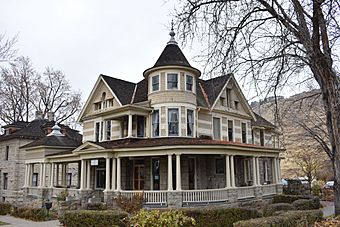Bishop Funsten House facts for kids
Quick facts for kids |
|
|
Bishop Funsten House
|
|

Bishop's House (Bishop Funsten House) in 2018
|
|
| Location | 2420 Old Penitentiary Rd., Boise, Idaho |
|---|---|
| Area | 2.5 acres (1.0 ha) |
| Built | 1889 |
| Built by | A.G. Lachapelle (original) |
| Architect | Tourtellotte, John E. & Company (1900 remodel) |
| Architectural style | Queen Anne |
| MPS | Tourtellotte and Hummel Architecture TR |
| NRHP reference No. | 83000256 |
| Added to NRHP | January 3, 1983 |
The Bishop Funsten House, also known as Bishop's House, is a historic building in Boise, Idaho. It was built in 1889 and has two and a half stories. This house was designed in the beautiful Queen Anne style.
For many years, it served as the home for the leader of St. Michael's Church. Later, it became the rectory for St. Michael's Cathedral until 1960. A famous architect named John E. Tourtellotte updated and expanded the house in 1900. The Bishop Funsten House was added to the National Register of Historic Places in 1983. This means it is an important historical site.
Contents
History of the Bishop's House
Early Days and First Construction
In 1867, Bishop Daniel Tuttle bought a city block in Boise. He paid $375 for the land. However, a house for the church leader wasn't built there until 1889. Before this, the church's home was on a different street.
In 1889, that old house was sold. A new house was then built at the corner of Idaho and 2nd Streets. A carpenter and undertaker named A.G. Lachapelle built this new home.
A Grand Rectory is Built
Reverend D.C. Patee was the first church leader to live in the new house. In 1891, a local newspaper called it "the finest rectory building in the Northwest." The house had many special features of the Queen Anne style. These included fancy metal decorations on the roof and a unique double overhang. It also had decorative posts on the front porch.
Bishop Funsten and Major Changes
Bishop James B. Funsten moved to Boise in 1899. He lived in the house until he passed away in 1918. In 1900, the house got a big makeover. Architect John Tourtellotte added a round tower on the corner. He also built a large porch that wrapped around the house.
Tourtellotte also added a layer of local Boise sandstone to the outside walls. This gave the main floor a strong, beautiful look. He even included a small, open structure called a gazebo at one end of the new porch.
New Names and New Uses
By 1902, the house was officially listed under Bishop Funsten's name. For many years, people simply called it the "bishop's house." In the 1950s and 1960s, it was sometimes called Bishop Tuttle House.
In 1960, Rt. Rev. Norman L. Foote was the last bishop to live there. After he moved out, the house was changed into a meeting place. In the 1960s, it even served as a voting location for elections.
Saving the House and Its New Home
In 1966, the house was renamed the Bishop Rhea Center. This was to honor Bishop Frank A. Rhea. It then became a fun place for older citizens to gather.
In 1975, the house faced a big challenge. It was going to be torn down! But the community worked together to save it. They moved the entire house from its original spot at 120 W Idaho St. It was carefully relocated to 2420 Old Penitentiary Road. At its new location, it is still known as Bishop's House.



